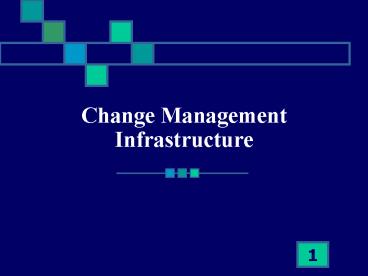Change ManagementInfrastructure - PowerPoint PPT Presentation
Title:
Change ManagementInfrastructure
Description:
Management process is designed to insure. That the software development changes ... Specific and repeatable process management for controlling change ... – PowerPoint PPT presentation
Number of Views:59
Avg rating:3.0/5.0
Title: Change ManagementInfrastructure
1
Change ManagementInfrastructure
2
Table of Contents
- Introduction
- Business Drivers
- Best Practices Principles
- Infrastructure
- Foundational requirements
- Key Points
- Benefits
3
Change Management Introduction
Change Management (aka Change Control) refers
To the process of managing the evolution of
Change over time. The Software Change
Management process is designed to insure
That the software development changes
Initiated by the software programming staff are
- Software Development Life Cycle Controlled,
autonomously tested, components approved and
promoted by the development teams, application QA
testers and Production Support staff - Change events documented and communicated in the
Change Calendar - Scheduled Installed via automated process with
associated automated rollback ability
4
Business Drivers
- Improved software quality
- Significant software development cost reductions
- Industry standards based software configuration
management best practices - Specific and repeatable process management for
controlling change - Historical change reporting, audit ability and
impact analysis - Reduced risk of system outage or failure -
improved system availability. - Compliance to internal and external audit
requirements.
5
Software Change Management Principles
- Centralized Source Control Library/Directory
Management(Secured) - Component/Artifact Versioning Control
- Component Promotion Management
- Approval Processing
- Independent/Autonomous QA/UA testing
- Process Flow Software Development Lifecycle
Control - Automated Software Component Rollback
- Project and Component level release mgmt
6
Foundational Change Management Requirements
Network Configuration Infrastructure
Software Configuration Management Infrastructu
re
Server Farming to provide a hardware
infrastructure for basic SCM Configuration i.e.
Development Servers QA/UA Servers Parallel Produ
ction Baseline Servers Production Runtime Servers
Automated Change Mgmt tool to provide Remote
Directory Browsing for Software Development Life
Cycle Mgmt across servers Standard TCP/IP Protoco
ls to facilitate cross server communications for
remote directory browsing and managing
components Automated User Mgmt functionality to c
ontrol application user access and software
development life cycle process flow navigation
ability Application specific deployment control t
o manage production runtime installation
7
Key Points
Common pitfalls encountered when establishing an
SCM Infrastructure
Network Configuration Infrastructure not
addressed in the initial planning phases (Must be
in place prior to any physical SCM effort)
Implementation not driven down into the
enterprise with Senior Mgmt Mandates
Enterprise culture change not anticipated and not
included in the project planning phases
ROI not fully developed to support project
implementation costs
8
Change ManagementBenefits
- The standardization of processes for change
control of new and existing applications would
significantly reduce the time required for
developing software components and
improving/expediting the pre-production testing
and production runtime application
deployment/rollback process. - Facilitate the establishment of a core set of
requirements guidelines for developing new
applications by insuring that the all software
development life cycle processes flow through the
same specific and repeatable source code
development practices. - Improved time to market for all software
development efforts. A structured software
development methodology followed by all
applications developers. - More robust impact analysis due to the historical
audit trails captured during the software
development life cycle process. - Support for more reliable trend analysis
reporting to measure developer coding standards,
production failures and the associated components
while reducing production downtime by improving
the quality of the software product deployed in
the production environment. - Last but not least, adherence to both internal
and external audit guidelines.































